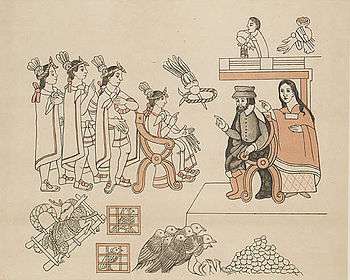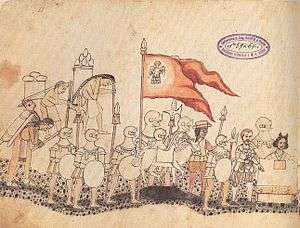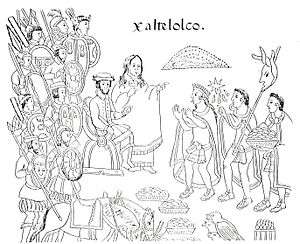La Malinche

La Malinche (Spanish pronunciation: [la maˈlintʃe]; c. 1496 or c. 1501 – c. 1529), known also as Malinalli [maliˈnalːi], Malintzin [maˈlintsin] or Doña Marina [ˈdoɲa maˈɾina], was a Nahua woman from the Mexican Gulf Coast, who played a role in the Spanish conquest of the Aztec Empire, acting as an interpreter, advisor, lover, and intermediary for Hernán Cortés. She was one of 20 women slaves given to the Spaniards by the natives of Tabasco in 1519.[1] Later, she became a mistress to Cortés and gave birth to his first son, Martín, who is considered one of the first Mestizos (people of mixed European and indigenous American ancestry).
The historical figure of Marina has been intermixed with Aztec legends (such as La Llorona, a woman who weeps for her lost children).[2] Her reputation has been altered over the years according to changing social and political perspectives, especially after the Mexican Revolution, when she was portrayed in dramas, novels, and paintings as an evil or scheming temptress.[3] In Mexico today, La Malinche remains iconically potent. She is understood in various and often conflicting aspects as the embodiment of treachery, the quintessential victim, or simply as symbolic mother of the new Mexican people. The term malinchista refers to a disloyal countryperson, especially in Mexico.
Life
La Malinche (also known as Malinalli or Malintzin) was born sometime between 1496 and 1501,[4] in region between the Aztec-ruled Valley of Mexico and the Maya states of the Yucatán Peninsula. She was named Malinalli after the Goddess of Grass, and later Tenepal meaning "one who speaks with liveliness."[5]
In her youth, her father Cacique of Paynala died, and her mother remarried another Cacique and bore a son. Now a stepchild, the girl was given to some people from Xicalango.[6]:85 Bernal Díaz del Castillo claims Malinalli's family faked her death by telling the townspeople that a recently deceased child of a slave was Malinalli. The Xicalango gave the child to the Tobascans.[6]:85
The Conquest of Mexico

Malinalli was introduced to the Spanish in April 1519, when she was among 20 slave women given by the Chontal Maya of Potonchán (in the present-day state of Tabasco) after the Spaniards defeated them in battle.[6] At this time, she was probably in her late teens or early 20s. Bernal Díaz del Castillo remarked on her beauty and graciousness; she was the only one of the slaves whose name he remembered. (He called her Marina, the Christian name she took upon being baptized in 1519.) Cortés singled her out as a gift for Alonso Hernandez Puertocarrero, perhaps the most well-born member of the expedition.[6]:82 Soon, however, Puertocarrero was on his way to Spain as Cortés' emissary to Charles V, and Cortés kept her by his side for her value as an interpreter who spoke two native languages: Mayan and Nahuatl.
According to Díaz, she spoke to emissaries from Moctezuma in their native tongue Nahuatl and pointed to Cortés as the chief Spaniard to speak for them. Cortés had located a Spanish priest, Gerónimo de Aguilar, who had spent several years in captivity among the Maya peoples in Yucatán following a shipwreck. Thus, he had learned some Mayan, but he did not speak Nahuatl. Cortés used Marina for translating between the Nahuatl language (the common language of central Mexico of that time) and the Chontal Maya language. Then Aguilar could interpret from Mayan to Spanish[6]:86 until Marina learned Spanish and could be the sole interpreter.
She accompanied Cortés so closely that Aztec codices always show her picture drawn alongside of Cortés. The natives of Tlaxcala, who formed an alliance with Cortés against Moctezuma, called both Marina and Cortés by the same name: Malintzin. (The -tzin suffix was the Nahuatl equivalent of "sir" or "lady" bestowed on them by the Tlaxcalans.)
According to surviving records, Marina learned of a plan by natives of Cholula to cooperate with the Aztecs to destroy the small Spanish army. She alerted Cortés to the danger and even pretended to be cooperating with her native informants while Cortés foiled their plot to trap his men. Cortés turned the tables on them and slaughtered many Cholulans.[6]
Following the fall of Tenochtitlán in late 1521 and the birth of her son Martín Cortés in 1522, Marina stayed in a house Cortés built for her in the town of Coyoacán, eight miles south of Tenochtitlán, the Aztec capital city, while it was being rebuilt as Mexico City. Cortés took Marina to quell a rebellion in Honduras in 1524–1526 when she is seen serving again as interpreter (suggestive of a knowledge of Maya dialects beyond Chontal and Yucatán.) While in the mountain town of Orizaba in central Mexico, she married Juan Jaramillo, a Spanish hidalgo.[7] Historians such as Prescott generally lost track of Marina after her journey to Central America. Some contemporary scholars have estimated that she died less than a decade after the conquest of Mexico-Tenochtitlan at some point in 1529.[8] Historian Sir Hugh Thomas in his book "Conquest" reports the probable date of her death as 1551, deduced from letters he discovered in Spain alluding to her as alive in 1550 and deceased after 1551.[9] She was survived by her son Don Martín, who would be raised primarily by his father's family, and a daughter Doña María who would be raised by Jaramillo and his second wife Doña Beatriz de Andrada.[10]
Role of La Malinche in the Conquest of Mexico

For the conquistadores, having a reliable interpreter was important enough, but there is evidence that Marina's role and influence were larger still. Bernal Díaz del Castillo, a soldier who, as an old man, produced the most comprehensive of the eye-witness accounts, the Historia Verdadera de la Conquista de la Nueva España ("True Story of the Conquest of New Spain"), speaks repeatedly and reverentially of the "great lady" Doña Marina (always using the honorific title Doña). "Without the help of Doña Marina," he writes, "we would not have understood the language of New Spain and Mexico." Rodríguez de Ocaña, another conquistador, relates Cortés' assertion that after God, Marina was the main reason for his success.
The evidence from indigenous sources is even more interesting, both in the commentaries about her role, and in her prominence in the codex drawings made of conquest events. In the Lienzo de Tlaxcala (History of Tlaxcala), for example, not only is Cortés rarely portrayed without Marina poised by his side, but she is shown at times on her own, seemingly directing events as an independent authority. If she had been trained for court life, as in Díaz's account, her relationship to Cortés may have followed the familiar pattern of marriage among native elite classes. The role of the Nahua wife acquired through an alliance would have been to assist her husband achieve his military and diplomatic objectives.[11]
Today's historians give great credit to Marina's diplomatic skills, with some "almost tempted to think of her as the real conqueror of Mexico."[12] In contrast with earlier parts of Díaz del Castillo's account, after Marina's diplomacy began assisting Cortés, the Spanish were forced into combat on one more occasion.[13]
Origin of the name La Malinche
The many uncertainties which surround Malinche's role in the Spanish conquest begin with her name and its several variants. At birth she was named Malinalli or Malinal after the Goddess of Grass, on whose name-day she was born. Later, her family added the name Tenepal which means “one who speaks much and with liveliness”.[14]
After being baptized, the 20 slave girls were distributed by Cortes among his Spanish captains. Malinalli then took the Christian name of Marina, to which the soldiers of Cortés added the Doña, meaning lady.[6]:80–82
It is not known whether Marina was chosen because of a phonetic resemblance to her actual name, or chosen randomly from among common Spanish names of the time. A Nahuatl mispronunciation of Marina as Malin plus the reverential "-tzin" suffix, formed the compounded title of Malintzin, which the natives used for both Marina and Cortes, because he spoke through her.[15]
Today in Mexican Spanish the word malinchismo and malinchista is used to denounce Mexicans who are perceived as denying their own cultural heritage by preferring foreign cultural expressions.[16]
Some historians believe that La Malinche saved her people from the Aztecs, who held a hegemony throughout the territory and demanded tribute from its inhabitants. Some Mexicans also credit her with having brought Christianity to the New World from Europe, and for having influenced Cortes to be more humane than he would otherwise have been. It is argued, however, that without her help, Cortes would not have been successful in conquering the Aztecs as quickly, giving the Aztec people enough time to adapt to new technology and methods of warfare. From that viewpoint, she is seen as one who betrayed the indigenous people by siding with the Spaniards. Recently a number of feminist Latinas have decried such a categorization as scapegoating.[14]
Malinche’s figure in contemporary Mexico
Malinche’s image has become a mythical archetype that Hispanic American artists have represented in various forms of art. Her figure permeates historical, cultural, and social dimensions of Hispanic American cultures.[17] In modern times and in several genres, she is compared with the figure of the Virgin Mary, La Llorona (folklore story of the woman weeping for lost children), and the Mexican soldaderas (women who fought beside men during the Mexican Revolution)[18] for their brave actions.
La Malinche's legacy is one of myth mixed with legend, and the opposing opinions of the Mexican people about the legendary woman. Many see her as the founding figure of the Mexican nation. Still many, however, continue to find the legends more memorable than the history, seeing her as a traitor, as may be assumed from a legend that she had a twin sister who went North and the pejorative nickname La Chingada associated with her twin.

Feminist interventions into the figure of Malinche began in 1960s. The work of Rosario Castellanos was particularly significant.[19] Her subsequent poem La Mallinche recast her not as a traitor but as a victim.[20] Mexican feminists defended Malinche as a woman caught between cultures, forced to make complex decisions, who ultimately served as a mother of a new race.[21]
References in modern culture
Malinalli is the main character in a 2011 historical novel by Helen Heightsman Gordon, Malinalli of the Fifth Sun: The Slave Girl Who Changed the Fate of Mexico and Spain.
La Malinche is the main protagonist in such works as the novel Feathered Serpent: A Novel of the Mexican Conquest by Colin Falconer, and The Golden Princess by Alexander Baron. In contrast, she is portrayed as a duplicitous traitor in Gary Jennings' novel Aztec. More recently she has been the focus in Malinche's Conquest by Ana Lanyon, a non-fiction account of the author's research into the historical and mythic woman who was La Malinche. A novel published in 2006 by Laura Esquivel portrays her as one of history's pawns who becomes Malinche (the novel's title). She appears as a Christian and protector of her fellow native Mexicans in the novel Tlaloc Weeps for Mexico by László Passuth.
La Malinche also appears in the adventure novel Montezuma's Daughter (1893) by H. Rider Haggard.
Her story is told in Cortez and Marina(1963) by Edison Marshall.
She is a key character in the opera La Conquista (2005) by Italian composer Lorenzo Ferrero.
In the novel Death of the Fifth Sun by the late Robert Somerlott, Malinche is the narrator.
In the fictional Star Trek universe, a starship, the USS Malinche was named for La Malinche. This was done by Hans Beimler, a native of Mexico City, who together with friend Robert Hewitt Wolfe later wrote a screenplay based on La Malinche called The Serpent and the Eagle.
Octavio Paz addresses the issue of La Malinche's role as the mother of Mexican culture in The Labyrinth of Solitude. He uses her relation to Cortés symbolically to represent Mexican culture as originating from rape and violation.
In the animated television series The Mysterious Cities of Gold, which chronicles the adventures of a Spanish boy and his companions traveling throughout South America in 1532 to seek the lost city of El Dorado, a woman called Marinche becomes a dangerous adversary. The series was originally produced in Japan, and when translated into English.
She was also referred to in the song "Cortez the Killer" by Neil Young.
In the 1973 Mexican film Leyendas macabras de la colonia, La Malinche's mummy is in the possession of Luisa, her daughter by Hernán Cortés, while her spirit inhabits a cursed painting.
A reference to La Malinche as Marina is made in the early 19th-century Polish novel The Manuscript Found at Saragossa, in which she is cursed for yielding her "heart and her country to the hateful Cortez, chief of the sea-brigands."[22]
Malinal is also a character in Graham Hancock's series of novels War God: Nights of the Witch (2013) and War God: Return of the Plumed Serpent (2014), which is a fictional story describing the events related to the Hernan Cortes' expedition to Mexico and the Spanish conquest of the Aztec empire.
See also
Further reading
- Cypess, Sandra Messinger. La Malinche in Mexican Literature: From History to Myth Austin: U. of Texas Press, 1991.
- Díaz del Castillo, Bernal (1963) [1632]. The Conquest of New Spain. J. M. Cohen (trans.). London: The Folio Society.
- Fuentes, Patricia de, editor and translator. The Conquistadors: First Person Accounts of the Conquest of Mexico. New York: Orion 1963.
- Karttunen, Frances. "Rethinking Malinche," in Indian Women: Gender Differences and Identity in Early Mexico. Norman: University of Oklahoma Press 1993.
- Karttunen, Frances. "Malinche and Malinchismo." Encyclopedia of Mexico. Chicago: Fitzroy Dearborn 1997, pp. 775 -778
- Maura, Juan Francisco.Women in the Conquest of the Americas. Translated by John F. Deredita. New York: Peter Lang, 1997.
- Paz, Octavio. The Labyrinth of Solitude. New York: Grove Press 1961.
- Somomonte, Mariano G. Doña Marina: "La Malinche". Mexico City: Edimex 1971.
- Townsend, Camilla. Malintzin's Choices: An Indian Woman in the Conquest of Mexico. Albuquerque: University of New Mexico Press 2006.
- Vivancos Pérez, Ricardo F. “Malinche.” Celebrating Latino Folklore: An Encyclopedia of Cultural Traditions. Vol. II. Ed. María Herrera-Sobek. Santa Barbara, CA: ABC-CLIO, 2012. 750-9.
References
- ↑ Thomas, Hugh. Conquest: Montezuma, Cortes, and the Fall of Old Mexico. New York: Simon & Schuster, 1993, pp. 171–172
- ↑ Cypess, p. 7
- ↑ Cypess, pp. 12–13
- ↑ Goetz, Philip W., ed. (1987), "Marina", The New Encyclopædia Britannica, 7, Chicago: Encyclopædia Britannica, p. 848
- ↑ Gordon, Helen Heightsman. Malinalli of the Fifth Sun: The Slave Girl Who changed the Fate of Mexico and Spain". Bloomington IN: iUniverse, Inc.: 2011, pages 1–5
- 1 2 3 4 5 6 7 Diaz, B., 1963, The Conquest of New Spain, London: Penguin Books, ISBN 0140441239
- ↑ Gordon, Helen. Voice of the Vanquished: The Story of the Slave Marina and Hernan Cortes. Chicago: University Editions, 1995, page 454.
- ↑ Chaison, Joanne. "Mysterious Malinche: A Case of Mistaken Identity," The Americas 32, N. 4 (1976).
- ↑ Thomas, Hugh. "Conquest:Mocteuma, Cortes, and the Fall of the Aztec Empire". New York: Simon and Schuster, 1993, page 769.
- ↑ Townsend, Camilla. Malintzin's Choices: An Indian Woman in the Conquest of Mexico. University of New Mexico Press, 2006, pp. 168–187.
- ↑ Restall, Matthew. Seven Myths of the Spanish Conquest
- ↑ Brandon, William (2003). The Rise and Fall of North American Indians. Lanham, MD: Roberts Rinehart Publishers. p. 88.
- ↑ Brandon, William (2003). The Rise and Fall of North American Indians. Lanham, MD: Roberts Rinehart Publishers. p. 88.
- 1 2 Cypess, p. 2
- ↑ Díaz 1963, p. 150
- ↑ Fortes De Leff, J. (2002). Racism in Mexico: Cultural Roots and Clinical Interventions1. Family Process, 41(4), 619-623.
- ↑ Cypess, Intro.
- ↑ Salas
- ↑ Castellanos, Rosario (1963). "Otra vez Sor Juana" ("Once Again Sor Juana")".
- ↑ Rolando Romero (2005-01-01). Feminism, Nation and Myth: La Malinche. Arte Publico Press. pp. 28–. ISBN 978-1-61192-042-0.
- ↑ Don M. Coerver; Suzanne B. Pasztor; Robert Buffington (2004). Mexico: An Encyclopedia of Contemporary Culture and History. ABC-CLIO. pp. 200–. ISBN 978-1-57607-132-8.
- ↑ Potocki, Jan; trans. Ian Maclean (1995). The Manuscript Found at Saragossa. Penguin Books.
External links
| Wikimedia Commons has media related to La Malinche. |
- Hernando Cortes on the Web : Malinche / Doña Marina (resources)
- Leyenda y nacionalismo: alegorías de la derrota en La Malinche y Florinda "La Cava", Spanish-language article by Juan F. Maura comparing La Cava and Mexican Malinche.
- in defense of Malinche
- Making Herself Indispensable, Condemned for Surviving: Doña Marina (Part 1)
- Making Herself Indispensable, Condemned for Surviving: Doña Marina (Part 2)
- La Malinche, an ambivalent interpreter from the past